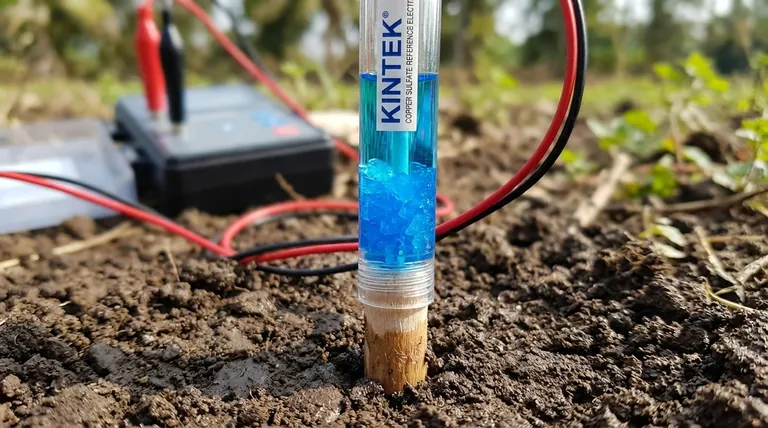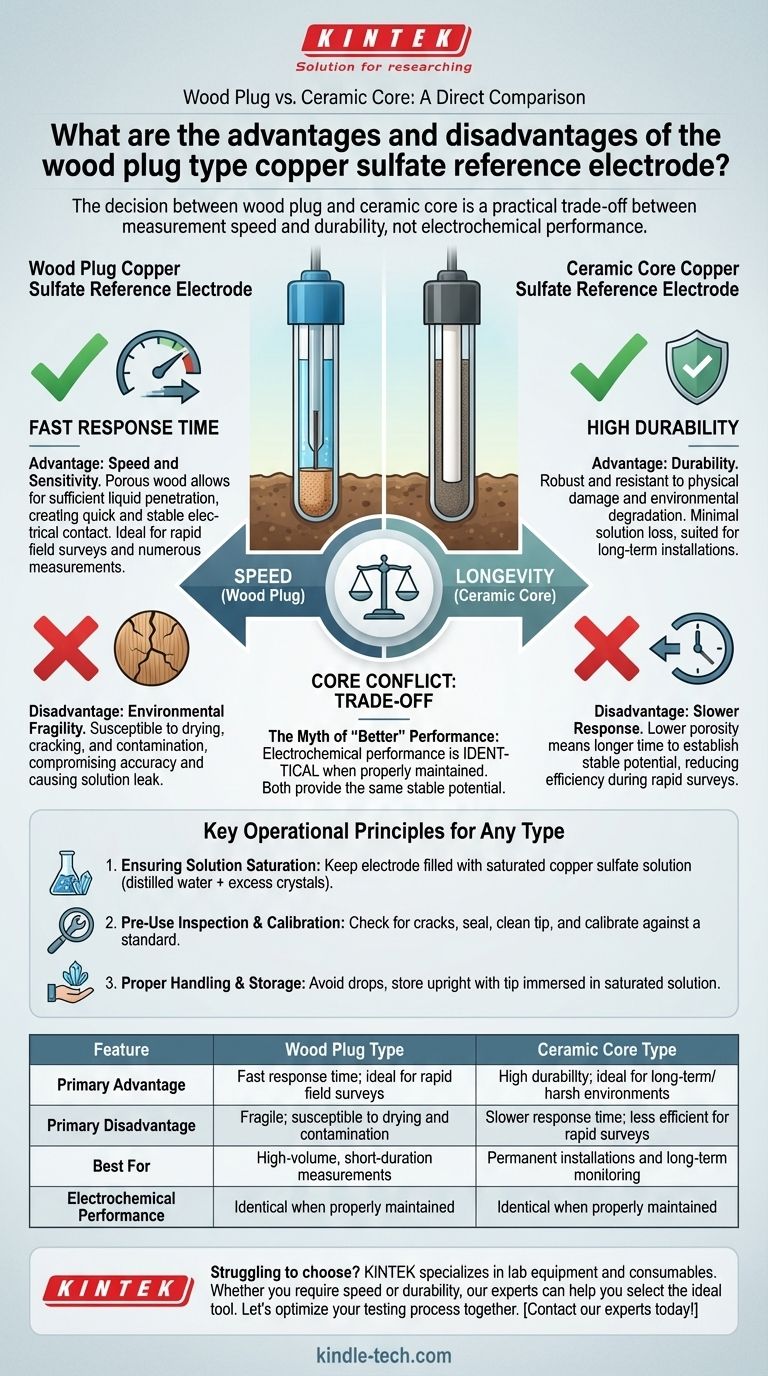The primary advantage of the wood plug copper sulfate reference electrode is its fast response time, which allows for rapid and efficient measurements. Its main disadvantage is the wood plug's susceptibility to damage from environmental factors, such as drying out or contamination, which can compromise the accuracy of its readings.
The decision between a wood plug and a ceramic core electrode is not about which has better electrochemical performance—they are identical. The choice is a practical trade-off between the wood plug's measurement speed and the ceramic core's superior durability in the field.

Wood Plug vs. Ceramic Core: A Direct Comparison
Both wood plug and ceramic core reference electrodes serve the same fundamental purpose: to provide a stable, known potential against which the potential of another material can be measured. The difference lies entirely in the physical interface that connects the internal solution to the external environment.
Advantage of Wood Plug: Speed and Sensitivity
The porous nature of the wood allows for sufficient liquid penetration, creating a quick and stable electrical contact with the electrolyte (e.g., soil or water).
This fast reaction speed is ideal for applications requiring numerous measurements in a short period, such as field surveys or pipeline inspections.
Disadvantage of Wood Plug: Environmental Fragility
The wood plug is susceptible to environmental changes. If it dries out and cracks, it can break the electrical circuit or cause the internal solution to leak excessively.
Contamination from the measurement environment can also clog the wood's pores, leading to slow response times and inaccurate readings.
Advantage of Ceramic Core: Durability
The primary advantage of the ceramic core type is its robustness and longevity. It is far more resistant to physical damage and environmental degradation.
Ceramic plugs also result in minimal loss of the internal electrode solution over time, making them better suited for long-term or permanent installations.
Disadvantage of Ceramic Core: Slower Response
The lower porosity of the ceramic material means it takes slightly longer to establish a stable potential. This slower reaction speed can reduce efficiency during rapid field surveys compared to the wood plug type.
Understanding the Trade-offs
Choosing the correct electrode requires understanding that the "best" option is entirely dependent on the application and operating conditions.
The Core Conflict: Speed vs. Longevity
The choice is a direct trade-off. The wood plug offers speed for rapid, high-volume testing, while the ceramic core offers reliability for long-term monitoring or use in harsh environments.
The Myth of "Better" Performance
It is critical to understand that the electrochemical performance of both types is identical. When functioning correctly, both provide the same stable potential. The difference is purely in the physical durability and response time of the plug.
The Universal Factor: Maintenance
Regardless of the type chosen, its reliability is overwhelmingly determined by proper handling and maintenance. A well-maintained wood plug electrode will always outperform a neglected ceramic one.
Key Operational Principles for Any Type
To ensure accurate and repeatable measurements, certain operational principles are non-negotiable for any copper sulfate reference electrode.
Ensuring Solution Saturation
The electrode must be filled with a saturated copper sulfate solution. This is typically achieved by adding distilled water to the internal chamber, ensuring excess copper sulfate crystals remain undissolved at the bottom. This guarantees the potential remains stable.
Pre-Use Inspection and Calibration
Before any measurement, always inspect the electrode's casing for cracks and ensure the cap is sealed. The porous tip must be cleaned of any residue. For maximum accuracy, the electrode's potential should be checked and calibrated against a known standard.
Proper Handling and Storage
Avoid dropping, squeezing, or subjecting the electrode to strong vibrations. When not in use, it should be stored upright in a cool, dry place, with its tip immersed in a saturated copper sulfate solution to prevent the plug from drying out.
Making the Right Choice for Your Application
Your final decision should be guided by the specific demands of your project.
- If your primary focus is rapid field surveys: The wood plug type is often preferred for its fast response time, allowing you to take more measurements efficiently.
- If your primary focus is long-term monitoring or use in harsh conditions: The ceramic core type's durability and lower solution loss make it a more reliable and lower-maintenance choice.
- If your primary focus is consistent accuracy regardless of type: Meticulous maintenance—including proper cleaning, storage, and regular calibration—is far more important than the choice of plug material.
Ultimately, the reliability of your measurements depends less on the plug material and more on your operational discipline.
Summary Table:
| Feature | Wood Plug Type | Ceramic Core Type |
|---|---|---|
| Primary Advantage | Fast response time; ideal for rapid field surveys | High durability; ideal for long-term/harsh environments |
| Primary Disadvantage | Fragile; susceptible to drying out and contamination | Slower response time; less efficient for rapid surveys |
| Best For | High-volume, short-duration measurements | Permanent installations and long-term monitoring |
| Electrochemical Performance | Identical when properly maintained | Identical when properly maintained |
Struggling to choose the right reference electrode for your specific application? KINTEK specializes in lab equipment and consumables, serving laboratory needs with expert guidance. Whether you require the speed of a wood plug electrode for field surveys or the robustness of a ceramic core for long-term monitoring, our team can help you select the ideal tool to ensure accurate and reliable measurements.
Let's optimize your testing process together. Contact our experts today!
Visual Guide

Related Products
- Copper Sulfate Reference Electrode for Laboratory Use
- Reference Electrode Calomel Silver Chloride Mercury Sulfate for Laboratory Use
- Metal Disc Electrode Electrochemical Electrode
- Rotating Platinum Disk Electrode for Electrochemical Applications
- Glassy Carbon Electrochemical Electrode
People Also Ask
- What is the expected lifespan of a copper sulfate reference electrode? Maximize Longevity with Proper Maintenance
- Is there a difference in performance between wood plug and ceramic core copper sulfate electrodes? Speed vs. Durability Explained
- What is the potential of copper sulfate reference electrode? A Stable +0.314 V Baseline for Field Measurements
- Where should the copper copper sulfate reference electrode be placed to obtain an accurate reading? Ensure Correct Structure-to-Soil Potential Measurement
- What is a permanent copper/copper sulphate reference electrode? A Key Tool for Accurate Corrosion Monitoring

















